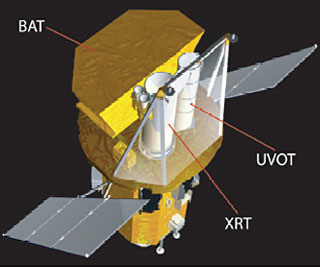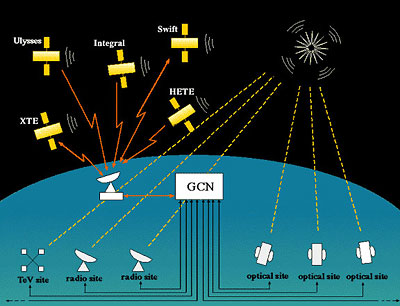Swift Instrumentation: Swift's three scientific instruments work together to learn as much as possible about gamma-ray bursts. The Burst Alert telescope (BAT) is the first instrument to detect gamma-rays in the quarter of the sky at which it is pointed. Then the satellite is reoriented using the source location determined by BAT so that XRT and UVOT, which have much smaller fields of view, can be pointed at the GRB. These instruments determine the source location to within a few arcseconds. With this information, ground-based telescopes can be pointed directly at the source to gather more data about the GRB.
Credit: NASA/Goddard Space Flight Center
Swift has an instrument called the Burst Alert Telescope (BAT). When the BAT detects a gamma-ray burst that’s significantly above the background rate, it triggers a burst detection. In about 10 seconds it can calculate the location of the burst. This means Swift is fast enough to actually catch a GRB in the act. Then a computer on board Swift immediately transmits the location and the burst’s intensity to the world through the GRB Coordinates Network (GCN) so that ground-based telescopes can search that area of the sky for the afterglow – the energy from the GRB as it fades to longer wavelengths like X-rays and visible light. Analyzing afterglow spectra is how we determine the composition of and distance to the GRB. So when a burst is detected – and that happens several times a month – imagine that people all over the world are getting paged and called and instant-messaged and emailed all at the same time with news of this event way out in space.
Swift has two other instruments on board, the X-ray Telescope (XRT) and the Ultraviolet/Optical Telescope (UVOT). These are just normal focusing narrow-field telescopes. When we detect a gamma-ray burst, Swift immediately slews and points these instruments at the direction of the burst so we can look at it in the X-ray and optical wavelengths. These instruments complement each other – the BAT uses coded aperture imaging to look over a wide field of the sky and the XRT and UVOT have narrow fields of view for a more detailed look at the area of the GRB.
GRB Coordinates Network: Schematic of the GRB Coordinates Network (GCN), a system that distributes information about the location of a gamma-ray burst (GRB). The spacecraft sends the GRB location information down to a ground station, which in turn relays it to the GCN at the NASA Goddard Space Flight Center.
Credit: NASA/Goddard Space Flight Center



